Numerical Simulation of Nonlinear Processes in the “Thruster—Downhole Motor—Bit” System While Extended Reach Well Drilling
Abstract
:1. Introduction
2. Materials and Methods
2.1. Determination of the Parameters of the Bit Operation
- —number of bit nozzles, units.
- —diameter of bit nozzles, m.
- —specific moment on the bit, N · mm/N.
- —bit diameter, mm.
- —bit flushing unit flow rate (assumed to be 0.68).
- —drilling mud density, kg/m3.
- —drilling fluid consumption, L/s.
- —total area of flush nozzles of the bit, m2.
2.2. Determination of the Parameters of the Hydraulic Downhole Engine
- —shaft torque, N · m.
- —differential pressure during idle operation (for this downhole motor, = 482,633 Pa), Pa.
2.3. Determination of the Parameters of the Hydraulic Thrusting Device
- —total area of holes in the diaphragm, m2.
- —area of the inner section of the adapter, m2.
- —the number of holes in the diaphragm, units.
- —diameter of holes in the diaphragm, m.
- —outer diameter of the choke spear, m.
- —inner diameter of the upper adapter, m.
- —consumption of drilling mud, L/s.
- —drilling mud density, kg/m3.
- , —flow through the diaphragm and the bushing, respectively, L/s.
- , —the area of the internal section of the diaphragm and bushing, respectively, m2.
2.4. Drawing a Dynamic Model of the System “Hydraulic Thrusting Device—Downhole Motor—Bit”
- —WOB created by the hydraulic thrusting device, N.
- —friction force inside the hydraulic thrusting device, N.
- , —hydrostatic and hydrodynamic pressure, respectively, Pa.
- —area of ledges on the hydraulic thrusting device piston, m2.
- 1.
- The torque on the bit for the WOB generated by the hydraulic thrusting device is determined by:
- 2.
- The pressure drop in the hydraulic downhole motor is calculated according to (2).
- 3.
- The WOB created by a hydraulic thrusting device due to a change in pressure drop is calculated by:
- 4.
- Repetition of the calculation. The iterative process continues until the change in the WOB between the ith and i + 1 iterations is less than 200 N.
3. Results
- 1.
- The dependence of the pressure drop in the system on the flow rate of the drilling mud (Figure 10).
- 2.
- The dependence of WOB on differential pressure (Figure 11).
- 3.
- The dependence of the WOB on the flow rate of the drilling mud (Figure 12).
- 4.
- The dependence of the WOB on the zenith angle (Figure 13).
- 5.
- The dependence of the WOB on the bit aggressiveness (Figure 14).
- —area of the perpendicular platform, m2.
- —area of the site inclined at an angle of 45° to the flow of drilling mud, m2.
- —average value of pressure acting on two sites, Pa.


4. Discussion
5. Conclusions
- -
- The expediency of using hydraulic thrusting devices in the practice of drilling wells with the possibility of forecasting and the operational regulation of the parameters of the operation of the “Hydraulic Thrusting Device—Downhole Motor—Bit” system is confirmed. The calculation performed shows the ability of the device to create the necessary WOB when drilling with a PDC bit in medium rock, amounting to 72.7 kN.
- -
- A mathematical model was built based on the method of simple iterations and implemented in the Python environment, allowing for predicting the operating modes of a hydraulic thrusting device together with a downhole motor and a PDC bit. The results of the mathematical modeling show high convergence.
- -
- A mathematical calculation and computer simulation showed that the hydraulic thrusting device with a flow rate of drilling fluid in the range of 18–26 L/s is capable of creating a WOB in the range of 43 to 89 kN. The dependence of the WOB and drilling fluid flow rate is described by the equation shown in Figure 12. In addition, the simulation showed the versatility of the design of the hydraulic thrusting device, i.e., replacing the nozzle on the choke spear allows for a change in the WOB created by the thruster.
- -
- Based on the results of the modeling, a smooth increase in the WOB from 68.1 kN to 72.7 kN from the moment the mud pumps are turned on is theoretically substantiated and proved. The reason for this is a gradual decrease in the reactive moment on the bit. These dependencies are described in Equations (21) and (22), from which the values of the pressure drop of 2.22 MPa and the moment of 578 N · m were obtained.
- -
- The achieved results make it possible to determine the optimal drilling parameters when using a hydraulic thrusting device. When working directly in the field, it is assumed that there is software that provides the monitoring of the parameters of the device in a system with a downhole motor and a bit. Of particular importance is the monitoring of the pressure drop. If the positions of the protrusions on the instruments at the wellhead coincide, a rapid increase in the pressure drop by 2–3 times will be noticeable, characterizing the approach of the piston to one of the extreme positions. In this case, the field engineer should use the developed algorithm to determine the optimal operating parameters in changing geological and technological conditions.
- -
- To reproduce the described mathematical model, it is necessary to have the characteristics of the hydraulic thrusting device used, the downhole motor, and the bit, as well as the initial conditions of the experiment (torque on the bit, the WOB without taking into account the pressure of the hydraulic thrusting device, and the initial pressure drop in the system with the downhole motor immobilized). Further, it is necessary to apply the method of simple iterations for Equations (2), (21), and (22) until the changes in the drilling parameters become insignificant. Lastly, it is recommended to validate the obtained results in the AnSYS software environment.
Author Contributions
Funding
Data Availability Statement
Conflicts of Interest
References
- Litvinenko, V.; Dvoinikov, M. Methodology for determining the parameters of drilling mode for directional straight sections of well using screw downhole motors. J. Min. Inst. 2020, 241, 105. [Google Scholar] [CrossRef]
- Vadetskiy, U. Drilling of Oil and Gas Wells; Publishing Center «Akademia»: Moscow, Russia, 2003. Available online: https://www.geokniga.org/bookfiles/geokniga-yuv-vadeckiy-burenie-neftyanyh-i-gazovyh-skvazhin.pdf (accessed on 15 March 2023).
- Serbin, D.; Dmitriev, A. Experimental research on the thermal method of drilling by melting the well in ice mass with simultaneous controlled expansion of its diameter. J. Min. Inst. 2022, 257, 833–842. [Google Scholar] [CrossRef]
- Bolshunov, A.; Vasilev, D.; Ignatiev, S.; Dmitriev, A.; Vasilev, N. Mechanical drilling of glaciers with bottom-hole scavenging with compressed air. Ice Snow 2022, 62, 35–46. (In Russian) [Google Scholar]
- Litvinenko, V.; Petrov, E.; Vasilevskaya, D.; Yakovenko, A.; Naumov, I.; Ratnikov, M. Assessment of the role of the state in the management of mineral resources. J. Min. Inst. 2022, 259, 95–111. [Google Scholar] [CrossRef]
- Bogdanov, N. The Deepest Wells of Bashkiria; Bashkir Book Publishing House: Ufa, Russia, 1968. [Google Scholar]
- Shahnazarov, A. Pneumatic Control of the Drilling Rig—Kapelushnikov-Zalkin’s Console. Oil Ind. 1936, 8. Available online: https://oil-industry.net/pdf/1936/08/31_shakhnazarov.pdf (accessed on 15 March 2023).
- Danielyan, A.; Rustambekov, A. Test Results of the Hydraulic Bit Feed Controller of the Olovyanov and Gritsai System. Oil Ind. 1939, 8. Available online: https://oil-industry.net/pdf/1939/08/23_%D0%94%D0%B0%D0%BD%D0%B8%D1%8D%D0%BB%D1%8F%D0%BD.pdf (accessed on 15 March 2023).
- Hramenkov, V. Improvement of the Drilling Process and Drilling Equipment: Automation of Control of Technological Processes of Drilling Oil and Gas Wells; Profobrazovanie: Saratov, Russia, 2019. Available online: https://avidreaders.ru/read-book/avtomatizaciya-upravleniya-tehnologicheskimi-processami-bureniya-neftegazovyh-1.html (accessed on 15 March 2023).
- Aarsnes, J.; Auriol, J.; Di Meglio, F.; Shor, R. Estimating friction factors while drilling. J. Pet. Sci. Eng. 2019, 179, 80–91. [Google Scholar] [CrossRef]
- Tretyak, A.; Lirkevich, Y.; Borisov, K. Effect of Torsional and Longitudinal Vibrations on Drilling Rate and Formation of Breakage of Cutting Elements of Drill Bits Reinforced with PDC. Bulletin of the Tomsk Polytechnic University, 2019. Available online: https://www.mgri.ru/science/scientific-and-innovative-activity/dissertation-council/download/Dissertation_Borisov_K.V.pdf (accessed on 15 March 2023).
- Simonyants, S.; Al Taee, M. Stimulation of the Drilling Process with the Top Driven Screw Downhole Motor. J. Min. Inst. 2019, 238, 438. [Google Scholar] [CrossRef] [Green Version]
- Galkin, S.; Kochnev, A.; Zotikov, V. Estimate of Radial Drilling Technology Efficiency for the Bashkir Operational Oilfields Objects of Perm Krai. J. Min. Inst. 2019, 238, 410. [Google Scholar] [CrossRef]
- Kadochnikov, V.; Dvoynikov, M. Development of Technology for Hydromechanical Breakdown of Mud Plugs and Improvement of Well Cleaning by Controlled Buckling of the Drill String. Appl. Sci. 2022, 12, 6460. [Google Scholar] [CrossRef]
- Cebeci, M.; Kök, M. Analysis of sinusoidal buckling of drill string in vertical wells using finite element method. In Proceedings of the SPE Middle East Oil and Gas Show and Conference, OnePetro 2019, Manama, Bahrain, 18–21 March 2019. [Google Scholar] [CrossRef]
- Badretdinov, T.; Yamaliev, V. Analysis of drill string vibrations and utilization damping device. Oil Gas Bus 2016. Available online: http://ogbus.ru/files/ogbus/issues/6_2016/ogbus_6_2016_p5-22_BadretdinovTV_ru.pdf (accessed on 15 March 2023). [CrossRef] [Green Version]
- Ximao, L.; Jiaqi, Z.; Qiaojuan, G.; Chunying, F.; Yidi, S.; Ruoxi, Z. Hydraulic Thrusters. Pet. Sci. Technol. Forum 2016, 35, 87–90. [Google Scholar]
- Van, T.N. An extensive solution to prevent wax deposition formation in gas-lift wells. J. Appl. Eng. Sci. 2022, 20, 264–275. [Google Scholar] [CrossRef]
- Zifeng, L.; Changjin, W. Bit feed principles and operations of slide drilling. J. Pet. Sci. Eng. 2017, 152, 505–510. [Google Scholar] [CrossRef]
- Minin, A.; Pogarskiy, A.; Chefranov, K. Downhole Machine. Russian Patent SU121733A1, 15 December 1958. Available online: https://yandex.ru/patents/doc/SU121733A1_19590101 (accessed on 15 March 2023).
- Reich, M.; Hoving, P.; Makohl, F. Drilling Perfomance Improvements Using Downhole Thrusters. In Proceedings of the SPE/IADC Drilling Conference, Amsterdam, The Netherlands, 28 February–2 March 1995. [Google Scholar] [CrossRef]
- Buslaev, V.; Buslaev, G.; Loujikov, D.; Kuznetsov, N.; Gorbikov, A.; Manuilov, A.; Nester, N.; Milenkiy, A. Results of testing the multifunctional downhole bit feeder ZUPD-195. Constr. Oil Gas Wells Land Sea 2007, 11, 32–34. [Google Scholar]
- Peng, Y.; Zhang, H. Vibration evaluation and parameter optimization of hydraulic thruster. In Proceedings of the SPIE 10322, Seventh International Conference on Electronics and Information Engineering 2017, Nanjing, China, 17–18 September 2016; Volume 103223. [Google Scholar] [CrossRef]
- Jianjun, Z.; Xiaojie, C. Design and field test of hydraulic thruster. IOP Conf. Ser. Earth Environ. Sci. 2020, 558, 022067. [Google Scholar] [CrossRef]
- Bashir, M.; Abdesalam, N.; Abugharara, M.; Stephen, D. CFD Numerical Simulation for Downhole Thruster Perfomance Evaluation. In Proceedings of the ASME 2018, 37th International Conference on Ocean, Offshore and Arctic Engineering OMAE 2018, Madrid, Spain, 17–22 June 2018. [Google Scholar] [CrossRef]
- Tsirel’, S. Phenomenon of dilatancy in fragmented rocks. J. Min. Inst. 2011, 190, 176. Available online: https://pmi.spmi.ru/index.php/pmi/article/view/6445 (accessed on 15 March 2023).
- Gee, R.; Hanley, C.; Hussain, R.; Canuel, L.; Martinez, J. Axial Oscillation Tools vs. Lateral Vibration Tools for Friction Reduction—What’s the Best Way to Shake the Pipe? In Proceedings of the SPE/IADC Drilling Conference and Exhibition, London, UK, 17–19 March 2015. [Google Scholar] [CrossRef]
- Al ali, A.; Barton, S.; Mohanna, A. Unique Axial Oscillation Tool Enhances Perfomance of Directional Tools in Extended Reach Applications. In Proceedings of the SPE Brasil Offshore, Macae, Brazil, 14–17 June 2011. [Google Scholar] [CrossRef]
- Maidla, E.; Haci, M.; Jones, S.; Cluchey, M.; Alexander, M.; Warren, T. Field Proof of the New Sliding Technology for Directional Drilling. In Proceedings of the SPE/IADC Drilling Conference, Amsterdam, The Netherlands, 23–25 February 2005. [Google Scholar] [CrossRef]
- Dvoynikov, M. Technology of Drilling Oil and Gas Wells with Upgraded Screw Downhole Engines: Scientific Generalization, Research Results and Implementation—Diss. for the deg. D.Eng. 2011. Available online: https://www.geokniga.org/books/14667 (accessed on 15 March 2023).
- Baldenko, D.; Baldenko, F.; Tchaikovskiy, G. Theory and methodology for calculating a hydraulic thruster when drilling with downhole motors. Drill. Oil 2018. Available online: https://burneft.ru/archive/issues/2018-10/36 (accessed on 15 March 2023).
- Sultanov, B.; Shammasov, N. Downhole Drilling Machines and Tools; Nedra: Moscow, Russia, 1976. [Google Scholar]
- Gerasimova, I.G.; Oblova, I.S.; Golovina, E.I. The Demographic Factor Impact on the Economics of the Arctic Region. Resources 2021, 10, 117. [Google Scholar] [CrossRef]
- Lyagov, I.; Baldenko, F.; Lyagov, A.; Yamaliev, V.; Lyagova, A. Methodology for calculating technical efficiency of power sections in small-sized screw downhole motors for the «Perfobur» system. J. Min. Inst. 2019, 240, 694. [Google Scholar] [CrossRef]
- Nikolaev, A.; Zaripova, N. Substantiation of analytical dependences for hydraulic calculation of high-viscosity oil transportation. J. Min. Inst. 2021, 252, 885–895. [Google Scholar] [CrossRef]
- Loseva, E.; Lozovsky, I.; Zhostkov, R.; Syasko, V. Wavelet Analysis for Evaluating the Length of Precast Spliced Piles Using Low Strain Integrity Testing. Appl. Sci. 2022, 12, 10901. [Google Scholar] [CrossRef]
- Trushkin, O.; Akchurin, H. PDC cutter pressure on plastic-brittle rock in the process of its destruction. J. Min. Inst. 2020, 244, 448–453. [Google Scholar] [CrossRef]
- Leonov, E.; Simonyants, S. Improvement of the Technological Process of Well Deepening; Publishing Center of Gubkin University: Moscow, Russia, 2014. Available online: https://www.geokniga.org/bookfiles/geokniga-sovershenstvovanie-tehnologicheskogo-processa-uglubleniya-skvazhiny.pdf (accessed on 15 March 2023).
- Rybak, J.; Khayrutdinov, M.; Kuziev, D.; Kongar-Syuryun, C.; Babyr, N. Prediction of the geomechanical state of the rock mass when mining salt deposits with stowing. J. Min. Inst. 2022, 253, 61–70. [Google Scholar] [CrossRef]
- Choupani, M.; Tabatabaee Moradi, S.S.; Tabatabaei Nejad, S.A. Study on Attapulgite as Drilling Fluid Clay Additive in Persian Gulf Seawater. Int. J. Eng. 2022, 35, 587–595. [Google Scholar] [CrossRef]
- Wujun, X.; Derong, Z.; Simeng, W.; Yangfeng, P. Simulation and Analysis on Flow Field of Nozzle Position of Hydraulic Thruster Based on CFD. Interntational J. Sci. Res. 2018, 7, 2319–7064. [Google Scholar] [CrossRef]
- Scherbakova, K.; Ovezov, B.; Kalendarova, L.; Kuznetsova, D. Cause of Vibration during Drilling. Neftegaz.Ru 2022. Available online: https://magazine.neftegaz.ru/articles/burenie/756505-analiz-vozniknoveniya-vibratsiy-v-protsesse-bureniya/ (accessed on 15 March 2023).
- Dvoynikov, M.; Sidorov, D.; Kambulov, E.; Rose, F.; Ahiyarov, R. Salt Deposits and Brine Blowout: Development of a Cross-Linking Composition for Blocking Formations and Methodology for Its Testing. Energies 2022, 15, 7415. [Google Scholar] [CrossRef]
- Burkhanov, R.N.; Lutfullin, A.A.; Maksyutin, A.V.; Raupov, I.R.; Valiullin, I.V.; Farrakhov, I.M.; Shvydenko, M.V. Algorithm of retrospective analysis for identification and localization of residual reserves of the developed multi-layer oil field. Georesursy 2022, 24, 125–138. [Google Scholar] [CrossRef]
- Tsyglianu, P.P.; Romasheva, N.V.; Fadeeva, M.l.; Petrov, I.V. Engineering projects in the russian fuel and energy complex: Actual problems, factors and recommendations for development. Ugol 2023, 3, 45–51. (In Russian) [Google Scholar] [CrossRef]
- Duryagin, V.; Nguyen Van, T.; Onegov, N.; Shamsutdinova, G. Investigation of the Selectivity of the Water Shutoff Technology. Energies 2023, 16, 366. [Google Scholar] [CrossRef]
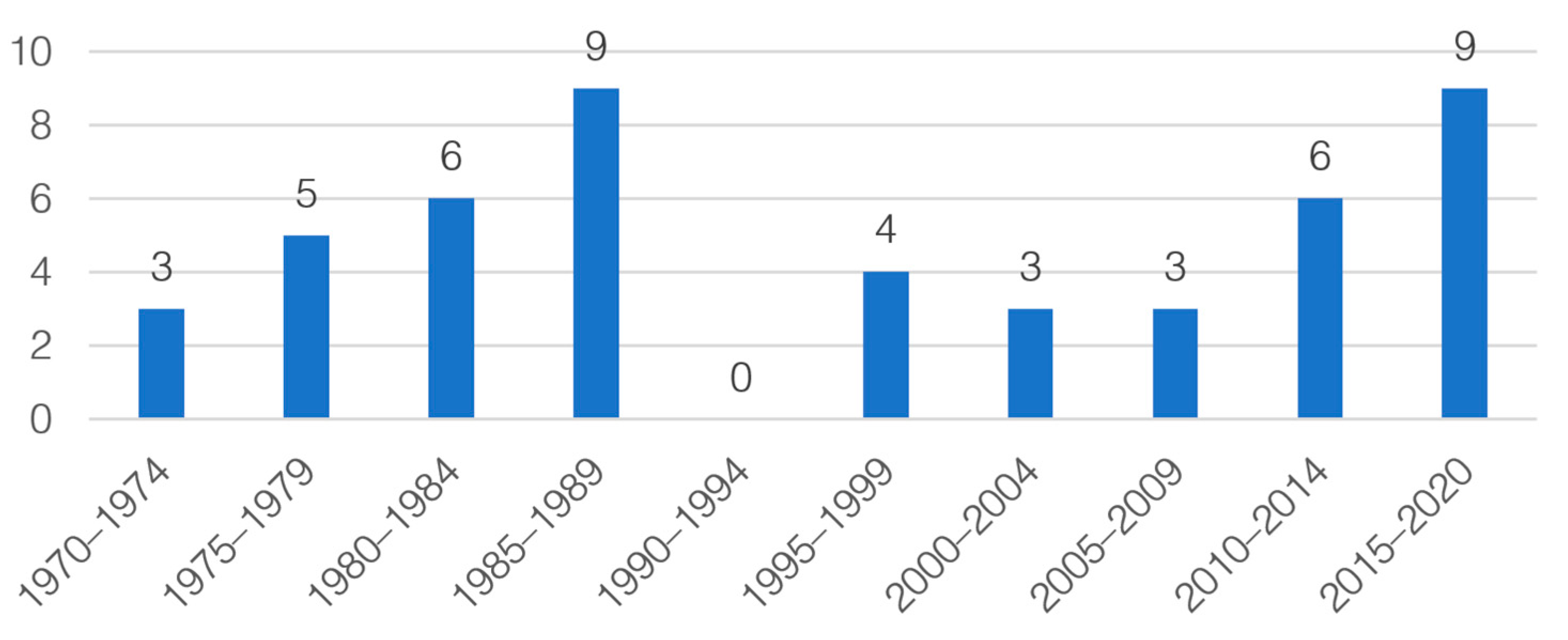



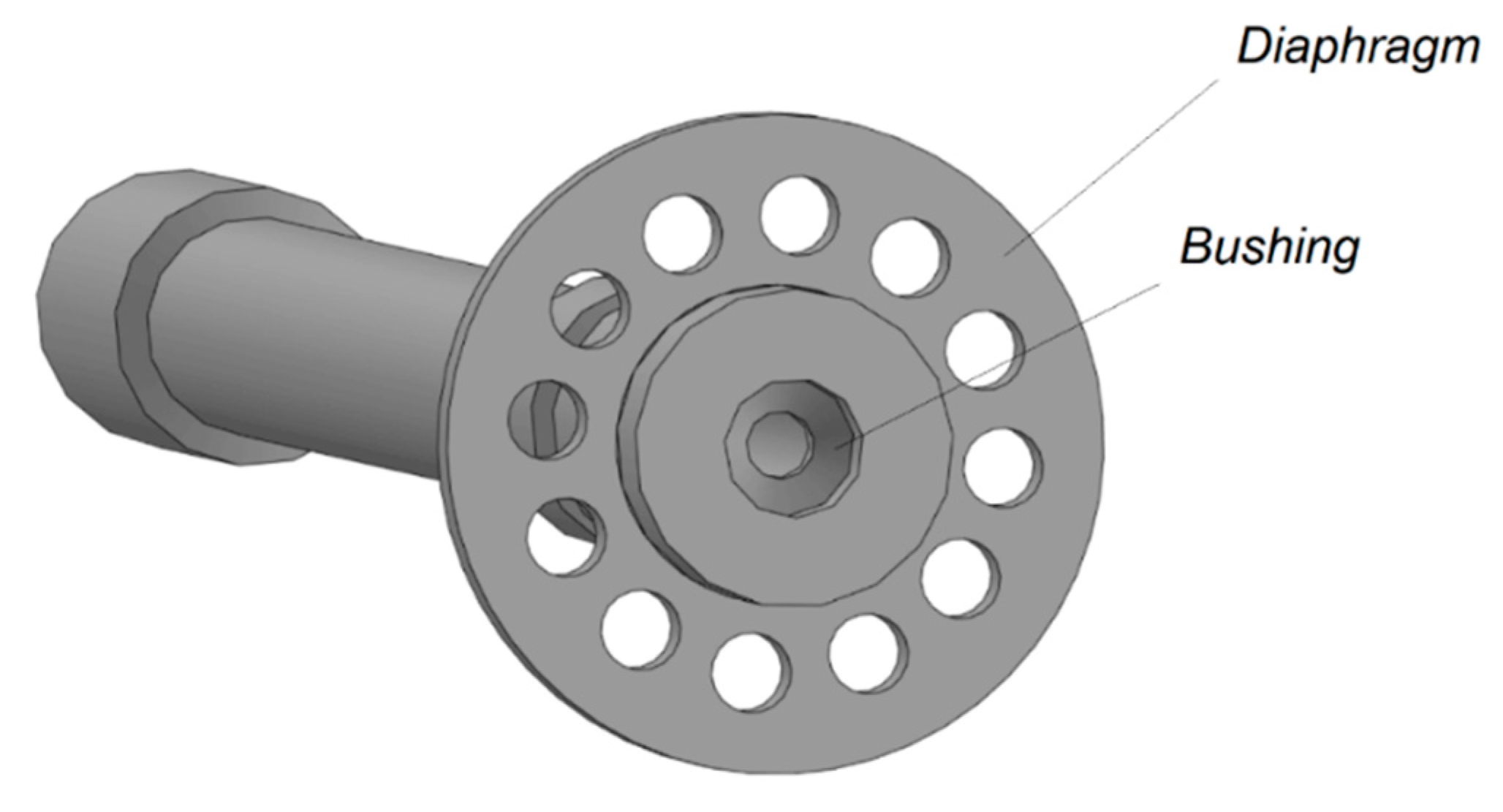


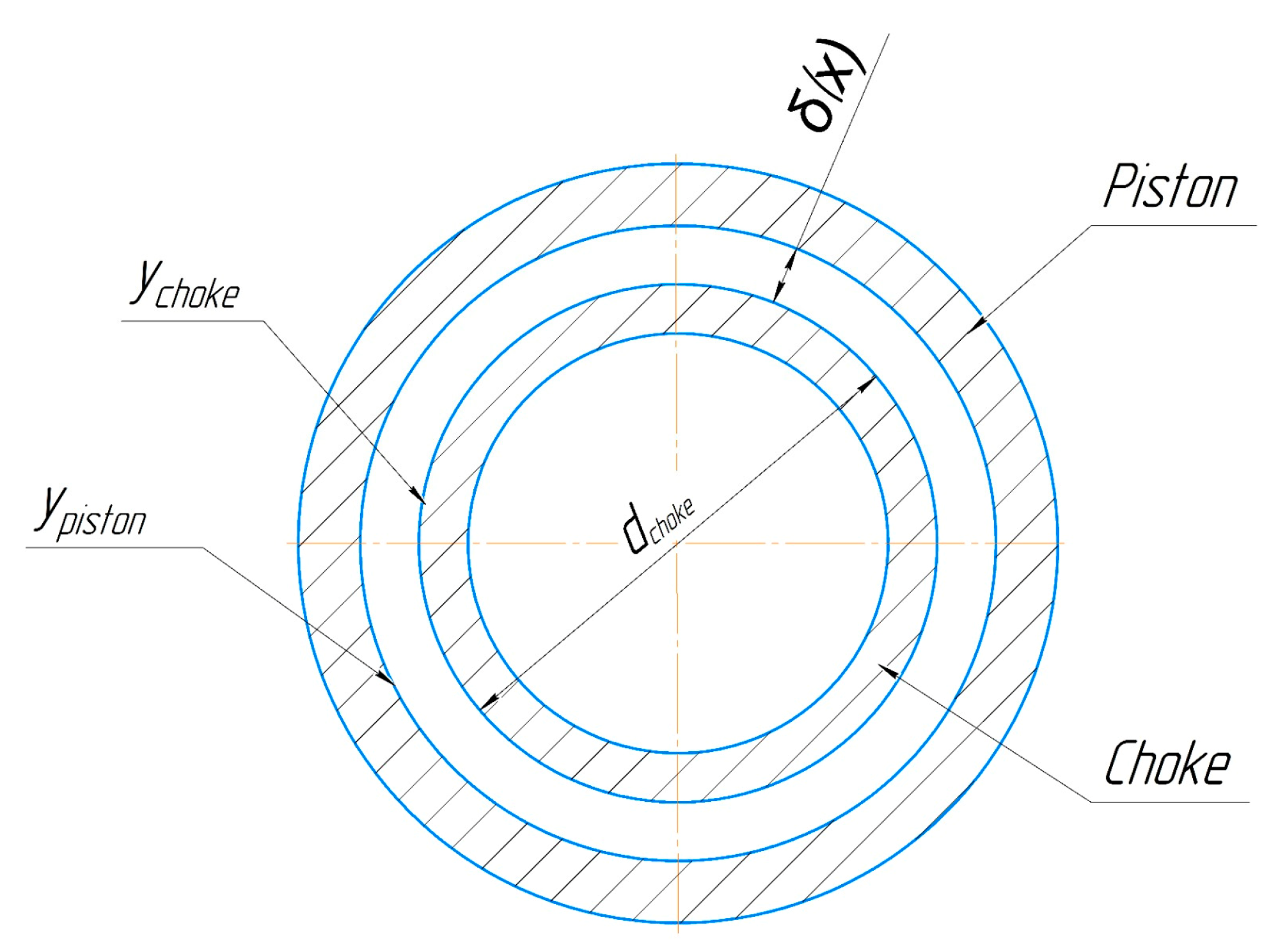
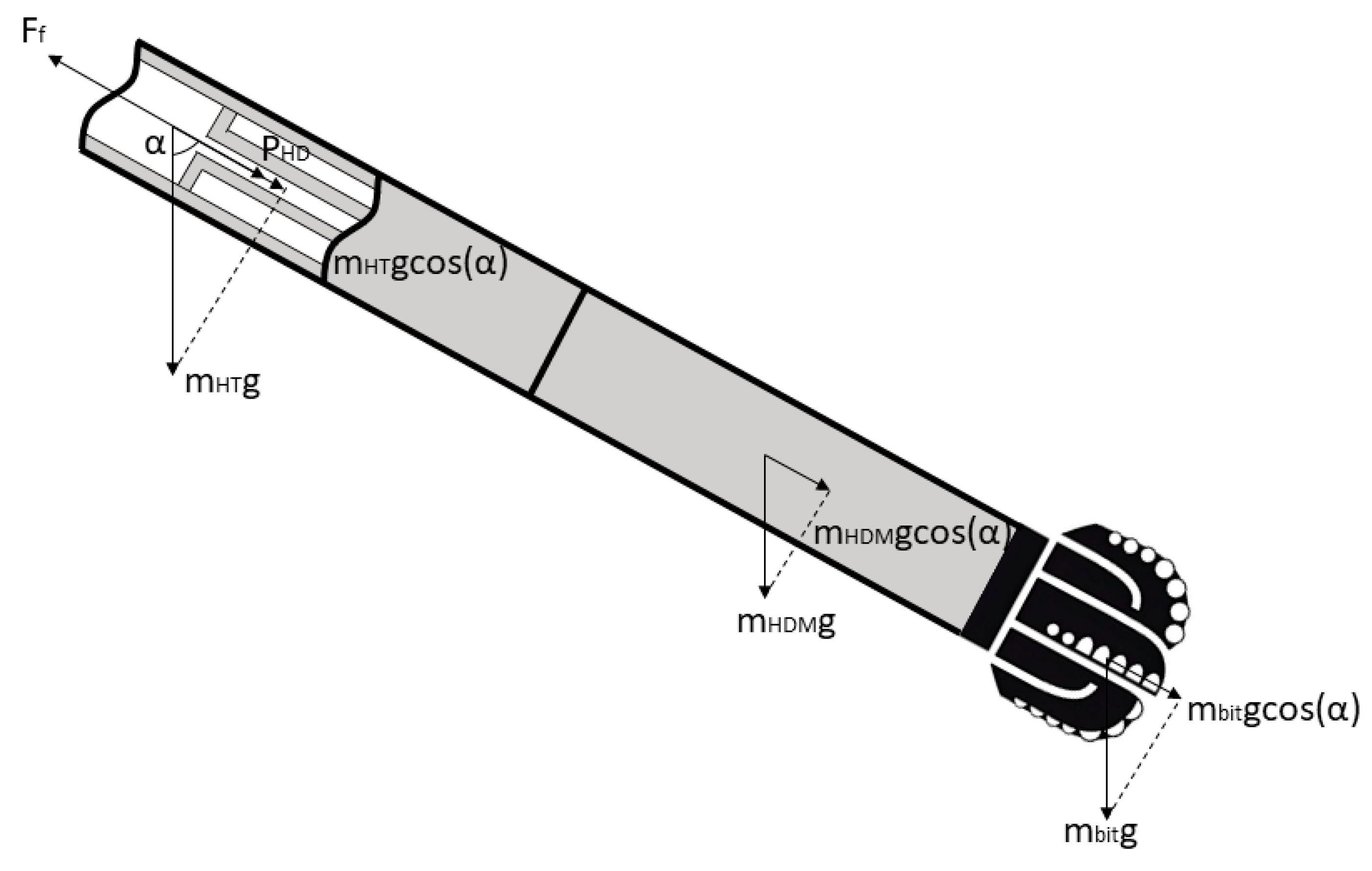

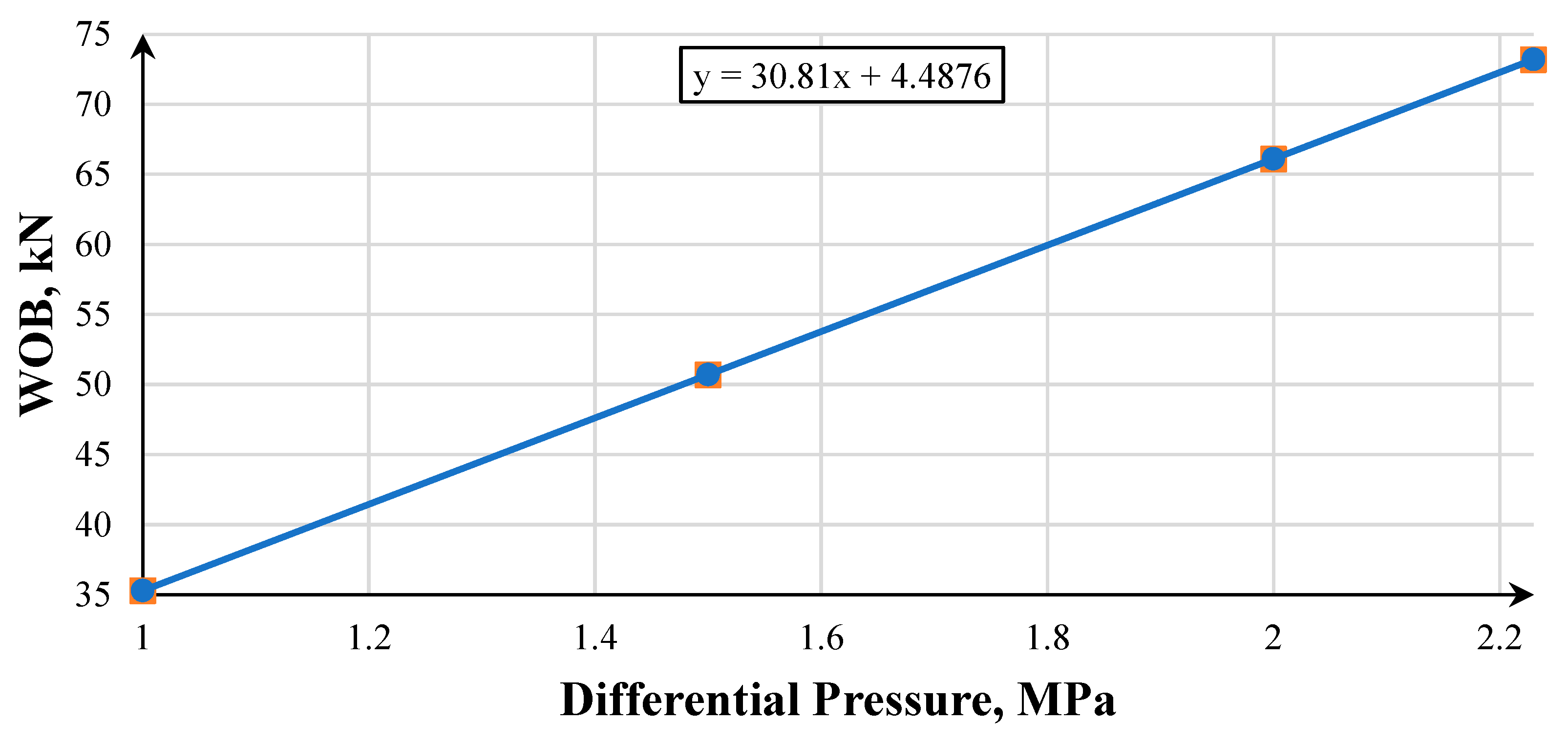

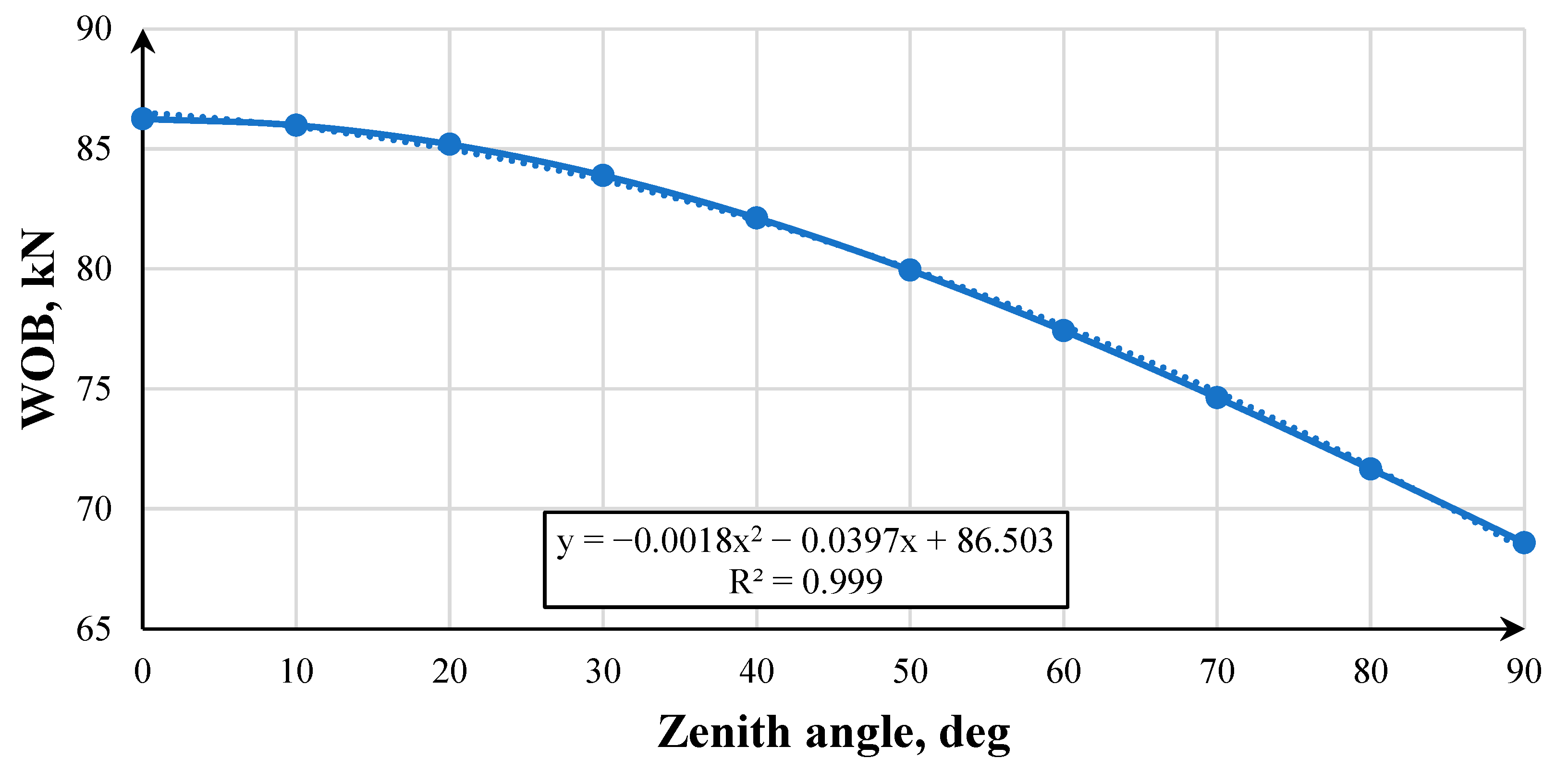
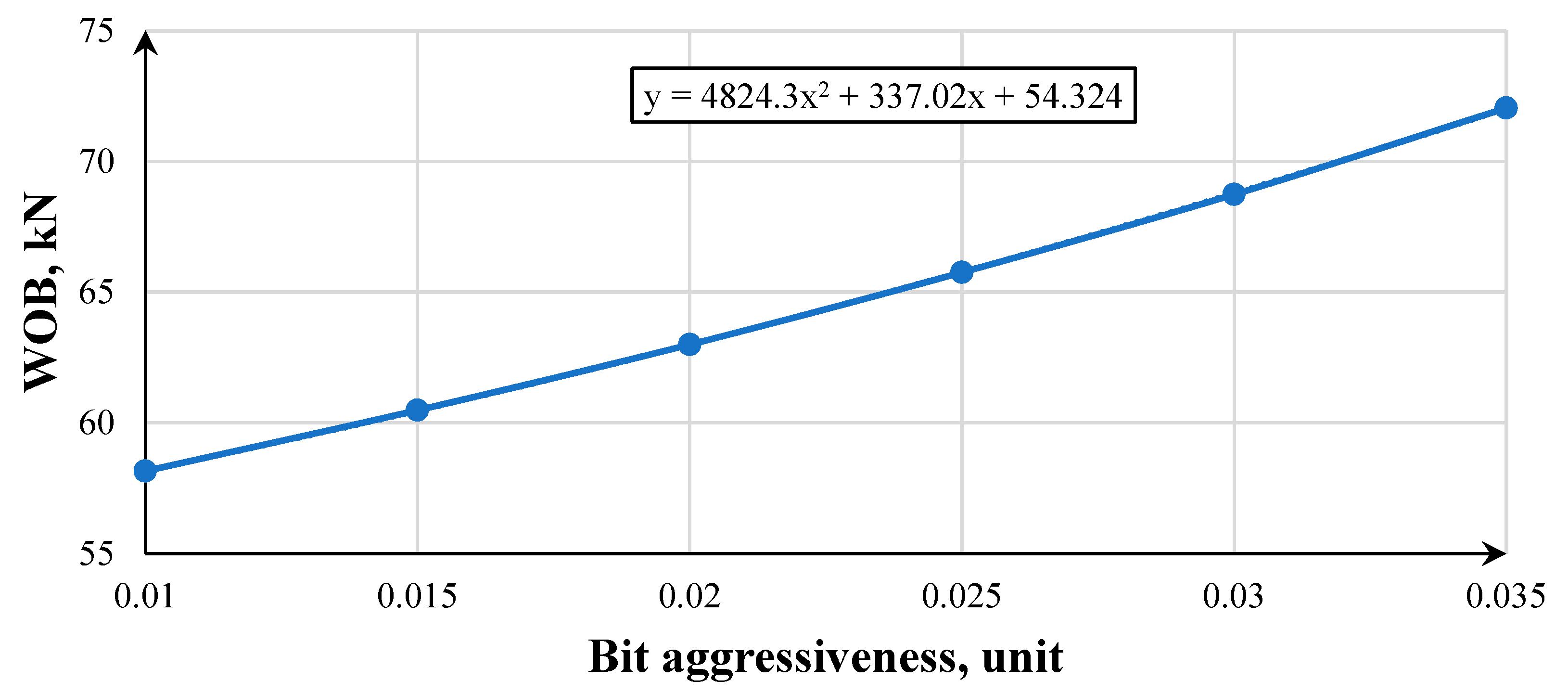
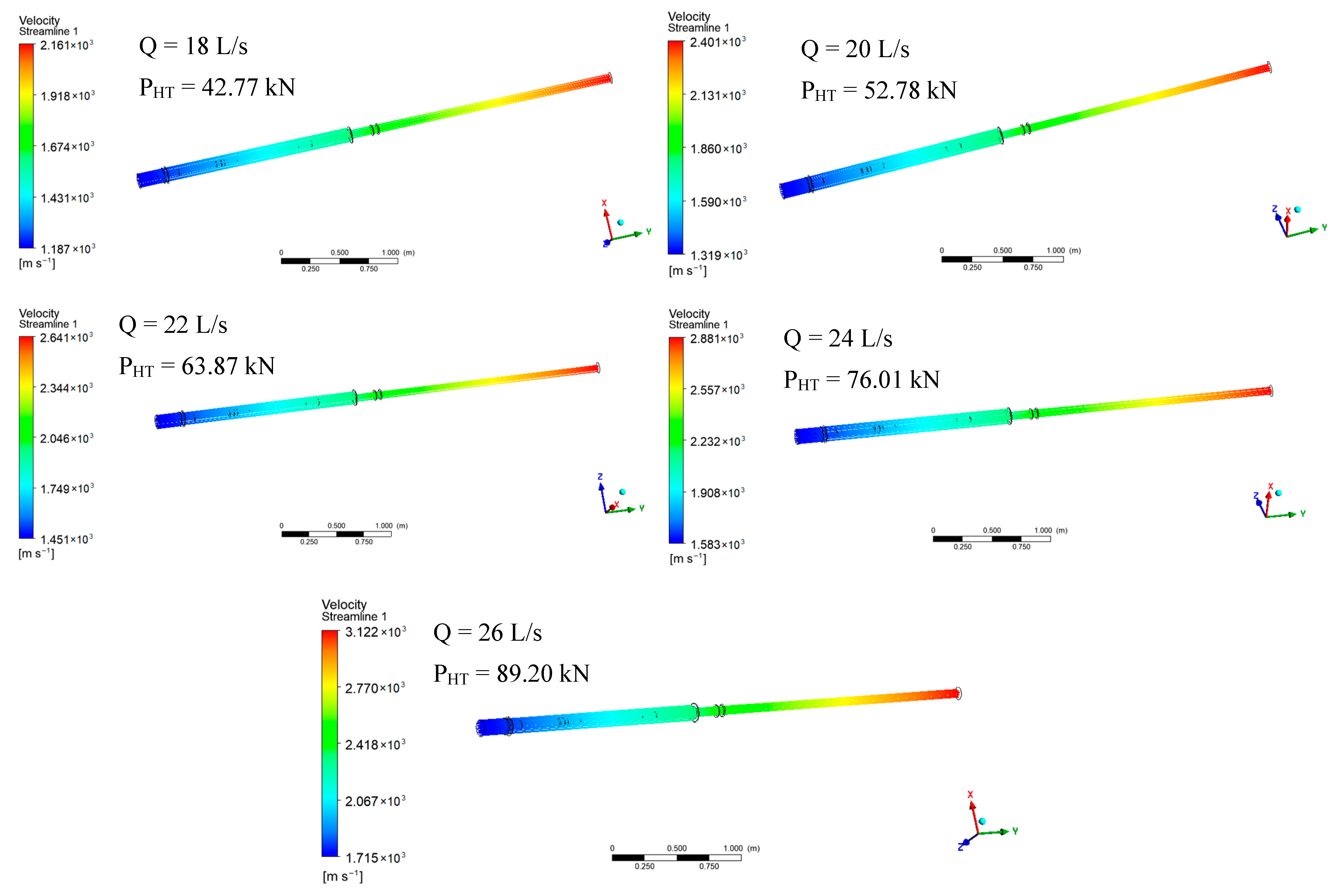
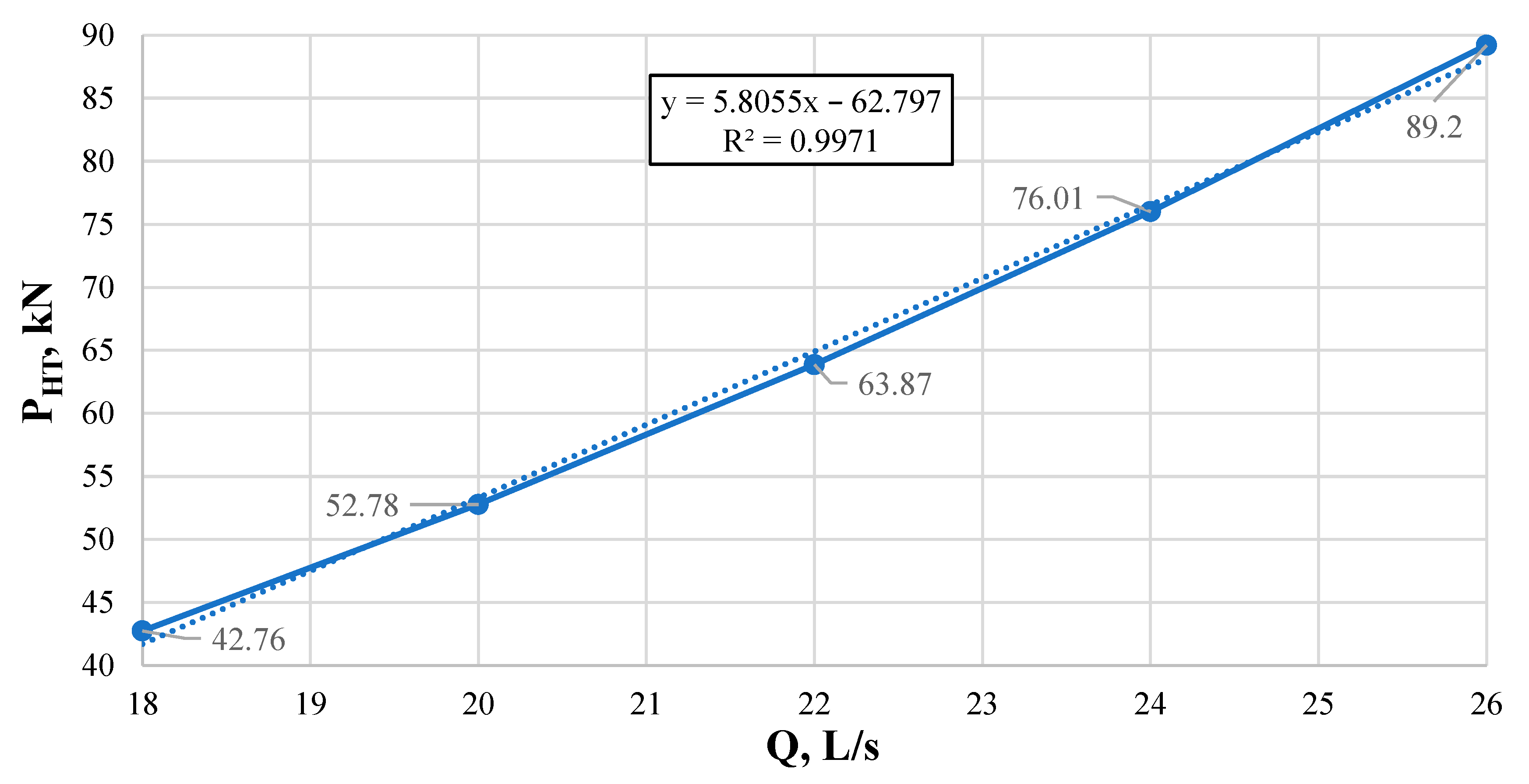
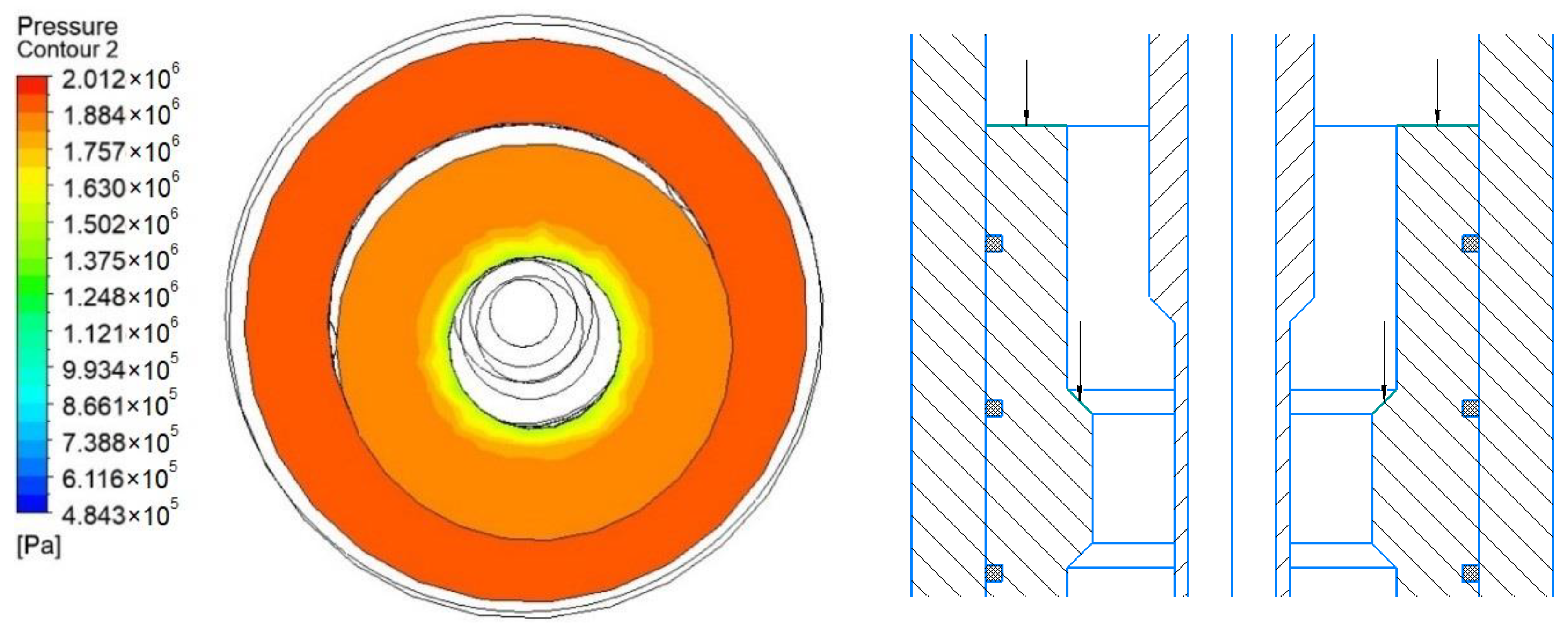


| Initial Data | Designation | Value |
|---|---|---|
| Parameters related to the drilling process | ||
| Drilling mud consumption, L/s | Q | 26 |
| Drilling mud density, kg/m3 | 1100 | |
| Inclination angle, ° | 75 | |
| Parameters of hydraulic thrusting device | ||
| Weight of hydraulic thrusting device, kg | 457 | |
| Hydraulic thrusting device piston diameter, mm | 170 | |
| Choke spear diameter, mm | 55 | |
| Piston stroke length, mm | 1600 | |
| Inner diameter of the choke spear nozzle, mm | 17 | |
| Number of diaphragm holes, units | 12 | |
| Diameter of diaphragm openings, mm | 20 | |
| Upper adapter inner diameter, mm | 127 | |
| Piston projection surface area, cm2 | 30.8 | |
| Downhole motor parameters | ||
| Downhole motor weight, kg | 1000 | |
| Downhole motor pressure drop, kPa | 482.6 | |
| Bit parameters | ||
| Bit weight, kg | 65 | |
| Bit diameter, mm | 215.9 | |
| Number of bit nozzles, units | 6 | |
| Bit jet nozzles diameter, mm | 12 | |
| Iteration Number i | Torque M, N · m | WOB, kN | WOB Increment ΔP, N |
|---|---|---|---|
| 1 | 411 | 68.1 | 13,654 |
| 2 | 515 | 71.5 | 3424 |
| 3 | 541 | 72.4 | 859 |
| 4 | 547 | 72.7 | 215 |
| 5 | 549 | 72.7 | 54 |
| Parameter | Unit of Measurement | Value |
|---|---|---|
| Torque | 578 | |
| Pressure drop | MPa | 2.22 |
| WOB | kN | 72.7 |
| Drilling mud density | kg/m3 | 1100 |
| Drilling mud consumption | L/s | 20 |
| Inclination angle | grad. | 75 |
Disclaimer/Publisher’s Note: The statements, opinions and data contained in all publications are solely those of the individual author(s) and contributor(s) and not of MDPI and/or the editor(s). MDPI and/or the editor(s) disclaim responsibility for any injury to people or property resulting from any ideas, methods, instructions or products referred to in the content. |
© 2023 by the authors. Licensee MDPI, Basel, Switzerland. This article is an open access article distributed under the terms and conditions of the Creative Commons Attribution (CC BY) license (https://creativecommons.org/licenses/by/4.0/).
Share and Cite
Kunshin, A.A.; Buslaev, G.V.; Reich, M.; Ulyanov, D.S.; Sidorkin, D.I. Numerical Simulation of Nonlinear Processes in the “Thruster—Downhole Motor—Bit” System While Extended Reach Well Drilling. Energies 2023, 16, 3759. https://doi.org/10.3390/en16093759
Kunshin AA, Buslaev GV, Reich M, Ulyanov DS, Sidorkin DI. Numerical Simulation of Nonlinear Processes in the “Thruster—Downhole Motor—Bit” System While Extended Reach Well Drilling. Energies. 2023; 16(9):3759. https://doi.org/10.3390/en16093759
Chicago/Turabian StyleKunshin, Andrey A., George V. Buslaev, Matthias Reich, Dmitriy S. Ulyanov, and Dmitriy I. Sidorkin. 2023. "Numerical Simulation of Nonlinear Processes in the “Thruster—Downhole Motor—Bit” System While Extended Reach Well Drilling" Energies 16, no. 9: 3759. https://doi.org/10.3390/en16093759
APA StyleKunshin, A. A., Buslaev, G. V., Reich, M., Ulyanov, D. S., & Sidorkin, D. I. (2023). Numerical Simulation of Nonlinear Processes in the “Thruster—Downhole Motor—Bit” System While Extended Reach Well Drilling. Energies, 16(9), 3759. https://doi.org/10.3390/en16093759







